A rich garlic harvest is the dream of every gardener. It’s no wonder that every autumn thorny, garlicky issues become relevant. When to plant garlic before winter? Which area should be selected? How to select seeds and plant them correctly? What fertilizers should I apply?
In this article we will reveal the secrets of successful planting of winter garlic. And at the same time we will try to answer the most main question— when to plant garlic in the fall.
So, in order.
When to plant winter garlic
It is important to plant such a useful and necessary archi crop on time. If you plant early, the cloves will take root, sprout and freeze in the winter. Too late - they won’t take root well, or won’t have time at all. The harvest will be weak, or there will be nothing to harvest, as the seed will disappear.
When to plant garlic before winter is, of course, an interesting question. Because no one will ever say the exact date. Even if you turn to lunar calendar, then it contains a good dozen dates. This year, for example, we are offered to plant garlic in September, October, and even November. How to navigate a gardener who is worried about the future harvest? How to choose the optimal date?
Planting garlic has long been associated with the Intercession, a major church holiday. According to the new style it is October 14, according to the old style it is October 1. According to legend, it is on this day that summer hands over the reins of power to winter.
I am sure that most experienced gardeners always focus on this date, taking into account weather conditions. So, with errors, the landing date can be called “October 14, plus or minus.”
What does it mean. In some regions, planting may occur earlier. This is Siberia, the Urals. In the southern regions, on the contrary, it is a little later. It turns out that garlic time begins at the end of September and lasts until the end of October. If the warm weather continues, in some regions you can start planting in November.
It turns out that the gardener himself determines for himself when to plant garlic before winter. They can help him folk signs, verified over centuries:
- When your hands get cold outside
- When it's cold to step barefoot on the ground
- When the white flies fly
- When are tulips planted?
- When the birds fly south
And to make sure you choose the right planting date, folk beliefs and specific weather conditions can be compared with the lunar calendar for 2017. Favorable days in September are 7,8,9,23 and 24. In October - 5,6,20 and 22. In November - 1,2,16,17,29 and 30.
How to choose the right garlic for planting

Here it is time to remember the proverb “What goes around comes around.” Therefore, for planting, you need to select the best heads with large and healthy cloves. Damage, traces of rot and mold are not acceptable on them.
It is necessary to separate the head into cloves on the day of planting so that they do not dry out. Look through each of them, make sure that the clove has a complete outer shell. You should not “undress” him. Garlic grown from a bare clove will be limp. It is only necessary to separate the mother's bottom, which will slow down rooting.
When planting, it is advisable to give preference to productive, winter-hardy and dry-resistant varieties that have good qualities storage The following varieties are valued among gardeners:
- Anniversary Gribovsky. Perhaps one of the best. Characterized by high yields. Resistant to pests and diseases. Well kept. It has a large onion with a number of cloves from 5 to 8. It can weigh 40 grams.
- Yubileiny 07. Also refers to fruitful and resistant varieties. Well kept. Number of cloves 5 – 8.
- Lyubasha. A wonderful variety, winter and dry-resistant. Can be stored for 10 months without losing quality. The bulb weighs 10 - 15 grams, the number of cloves ranges from 7 pcs.
- White Ukrainian. This variety does not bolt and stores well. Heads can weigh from 50 to 140 grams. It is distinguished by a large number of teeth, can have up to 12 pieces.
- Kharkov purple. It is characterized by high yields, resistance to diseases and pests. It has purple, rounded - flattened shape. It can weigh from 30 to 60 grams and have 6 cloves.
Choose a variety that would be better suited to the region of your residence. Only in this case can you count on a generous harvest. Pay attention to the fact that varieties that produce arrows will be more hardy and winter-hardy.
Many owners select the seed fund from their own harvest. The best heads are reserved for these purposes. Correct solution for several seasons. But from my own experience I can say that you need to update the seed every three to four years.
This can be done using garlic seeds from your own garden bed. They are called bulbs. During ripening, garlic produces arrows that we pick off. To improve the seed fund, you need to leave a few arrows.
Plant the collected bulbs at the same time as the main material. Only in a separate bed. In the first year, garlic - one-toothed garlic - will grow from the bulbs. By planting it in the second year, we will get a full-fledged bulb, thereby improving our garlic arsenal.
To the question whether it is necessary to treat the garlic cloves before planting, I will answer this way. I know that some gardeners soak the seed in a light solution of potassium permanganate. But I don't do that. I simply select high-quality material and fertilize the soil well. I believe that the correct implementation of agricultural technology allows you to harvest abundant harvests.
How to choose a place to plant garlic in the fall
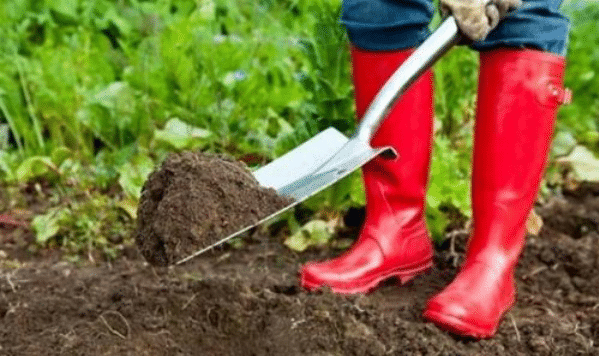
The first thing to do is change the area. Garlic does not like to grow in one place for two years in a row.
Garlic does not respect areas after onions and nightshades - tomatoes, peppers, blue peppers. A good new place would be where zucchini, pumpkins, and cucumbers grew. It will grow well in place of cabbage and legumes. She loves strawberries as a neighbor.
Which areas are preferable for planting?
- With a flat, elevated surface that will not be flooded in the spring
- With light sandy loam soil
- Well lit
- Excluding dampness.
Preparing the site for planting winter garlic
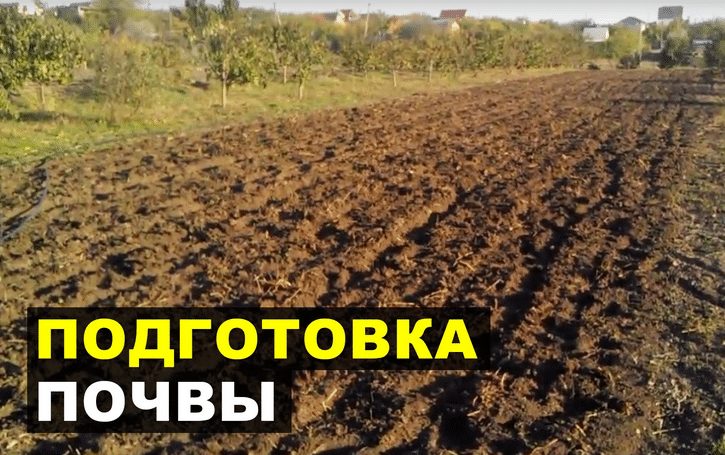
The site has been chosen, now we need to prepare it. It's better to do this in advance. At least 2 weeks before planting.
Each gardener is his own agronomist, having developed his own method of preparing and fertilizing the plot. I'll write how I do it. I can confidently advise. I’ve been planting garlic for many years, and I’m not offended by the yields. It lasts until the new season, and a decent amount is spent on clogging. For planting I only take a kilogram or one and a half kilograms.
So what to do
- Dig up the earth. Maintain the depth to the bayonet of the shovel.
- Select weeds and rocks.
- Rough up the land with a rake.
- Fertilize the soil. The most the best option there will be humus or compost. Apply as follows - a ten-liter bucket per two square meters. Use humus aged two years. Garlic does not tolerate fresh manure, as it contains a lot of nitrogen. The mail will become sour, and garlic respects fertile but neutral soils.
- Before planting, loosen the soil thoroughly.
- When planting, pour ash directly into the furrows. It will protect the cloves from rotting.
What else can you do to fertilize the soil?
- If there is no humus, you can use mineral fertilizers. Apply 20–30 grams of superphosphate and potassium fertilizer in an amount of 20 grams per square meter.
- You can add ammonium nitrate just before planting. Per square meter 10 g.
I want to emphasize that fertilizers must be applied taking into account specific conditions, not forgetting that garlic needs sandy loam, non-acidic soil. Not very dense and not very soft. Dense can push the seeds to the surface, they will simply freeze. Too soft can pull the teeth deeper, which will also negatively affect the harvest.
Rules for planting garlic in the ground
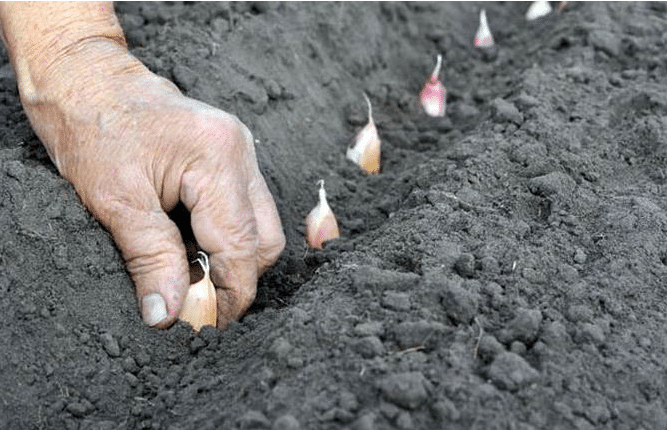
Before planting, the soil needs to be thoroughly loosened, because some time has passed since the preparation. The earth has dried up on top.
It is usually not necessary to water the area before planting - after all, it is very much in the yard, there is enough moisture. In dry autumns, you can water the day before planting.
Make grooves with a distance of 20 - 25 centimeters to a depth index finger. Another measure of depth is two cloves.
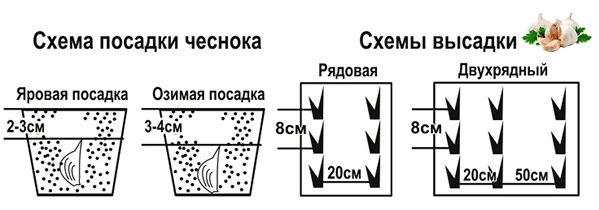
The cloves should be planted at a distance of 10 - 15 cm from each other. This is done after the bottom of the hole has been sprinkled with ash. You cannot press the clove into the ground, just carefully place it in the hole with the roots down. Make sure that the distance from the upper tip to the surface of the earth is 3.5 - 4 centimeters.
If you decide to plant bulbs in the fall, then they are placed in holes with a shallower depth. Five centimeters will be enough.
After planting, the ground must be leveled. Then mulch the area. This means covering the top with peat or sawdust. Foliage is perfect. Mulching will serve as additional fertilizer and will also protect the seeds from freezing. Effective layer – up to 4 cm.
Planted garlic is usually not watered. There is enough falling dew and autumn rains.
You can expect a good garlic harvest when there is a lot of snow on the site. Therefore, it is necessary to make sure that he lingers on the site. Place small branches and brushwood. And if necessary, you can even add snow manually in winter. But this is only if your area is small.
For the southern regions, such shelter for the winter will be enough. But in cold regions, the garlic needs to be covered more thoroughly. Make the layer of a warm blanket in the form of mulch thicker, up to 18 - 20 centimeters. Or use a covering material or special agrofibre.
With the onset of warm days, the mulch layer will need to be removed. Otherwise, our garlic will suffocate or spit out. And loosen the soil.
Plant for your health - garlic is a healthy thing. If you follow all the rules, everything will work out for you!
Planting garlic before winter is a responsible undertaking; here you need to choose the right planting material, correctly determine the timing of planting, know the subtleties and rules, nuances and features. Let me start with these nuances.
Bulbs or cloves?
Few people know (and maybe many), but I personally found out about this only about 15 years ago, that garlic as a crop has two different forms: one is called non-shooting, the second is shooting, which in our Tambov region has always been called simply "winter". What is an arrow? The simplest thing is an ordinary peduncle. The arrow is formed only winter garlic, that is, the one that we sow in the autumn.
In winter garlic, as we understand, which produces shoots, at the very end of the burning summer, bulbs begin to ripen on the peduncle, these are aerial bulbs, and in each inflorescence there can be a hundred pieces or even more.
It is also permissible to use these same bulbs for planting in the fall, but next season you will not get a full head of garlic cloves. From the bulb only a rather small onion will grow, weighing only 4-7 g, which we call one-toothed and is very quickly sold on the market for planting in the fall. The single clove will turn into a full-fledged head of garlic next summer. By the way, sometimes it’s quite large and has teeth in it.
Everything would be fine, but there are exceptions: there are also bulbs different sizes, and when you sow very small ones, then the next season the onions will not be very large. A high-quality harvest of large-sized garlic bulbs, cloved and ready for long-term storage, you can only get it after another season, that is, in the third year. Due to the rather slow development of garlic, when propagated in this way, sowing with bulbs is practiced in home plots only sometimes as an experiment or, more often, to preserve all the cultural characteristics of a certain variety of garlic.
Wintergreen - planting full garlic cloves before winter
Planting full cloves of garlic before winter, its popularity cannot be compared with sowing bulbs. By the way, what is a clove? A clove is, in essence, a daughter bulb that has a well-developed, active, living embryonic bud. And if there are a lot of such cloves of garlic (don’t think that there are at least three, maybe one, and a maximum of as many as seven pieces), which are arranged on a common bottom and carefully wrapped in covering scales, then this is already an onion, and a complex one at that.
From large - large
It is believed that the larger (larger) the planting material itself, the greater the harvest. That is, if we plant a hefty clove of garlic in the soil, then in the spring we are simply obliged to get a large onion with maximum number large teeth. If you plant a small clove, then the garlic bulb will be medium in size, best case scenario- with small or even one clove inside.
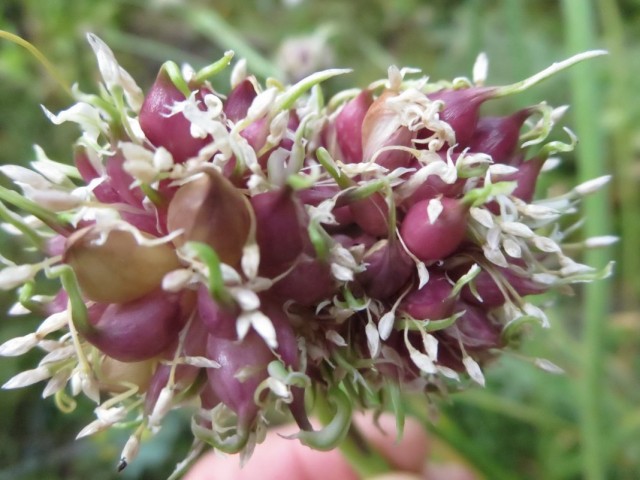 Aerated garlic bulbs - bulbs. © Lucy Martin
Aerated garlic bulbs - bulbs. © Lucy Martin
There's no point in regret
Beginners who have not grown garlic before usually take the largest cloves for food or storage, and plant the smaller ones on the plot. As a result, every year they have less and less harvests, although they remove the arrows on time (an important procedure, by the way: the arrows take up a lot of nutrition), but this technique does not help. If you don’t want to reduce your garlic yields to values close to zero, then for planting, try to divide the large cloves equally - half for food, and half for the harvest, and, naturally, use single cloves for planting.
Once every two or three years, I would advise reviving garlic in a separate small bed, that is, growing it from bulbs; this will not cause harm, only benefit.
When to plant garlic before winter?
Let's move on to the deadlines, this is important, but in many ways the deadlines also depend on climatic conditions. If we talk about the center of Russia, the optimal period for this is, of course, the very beginning of October. If we are talking about the south, then it is better to plant garlic no earlier than the end of October or, even better, no earlier than the beginning of October, in order to be completely safe. And if the conditions are Siberian, then hurry up.
As you can see, the deadlines are more than vague, but experienced gardeners long time those living in the same zone already have notes with a couple of secret signs in their stock of knowledge. For example, some seriously think that garlic must be planted before the Intercession, while others - the day after this great holiday.
I know that, for example, in the conditions of the Tomsk region, planting winter garlic begins annually on September 22-23 and (if it’s hot), then it is delayed until October 7. Friends from Ufa always take a vacation and on the very first day of it, starting on October 8th, they plant garlic. Of course, there are thermometers to help us, and we also need to listen to our intuition: the older a person is, the better developed it is. My grandfather in Kazan plants garlic, regardless of the weather outside - stubbornly - in the first ten days of October and has not deviated from this tradition for twenty years.
So, one general rule for planting garlic, regardless of calendar dates, states: the cloves should be in the soil one and a half months (maximum 50 days) before the onset of real frosts, when the soil temperature drops below nine degrees Celsius. This optimal time so that the garlic forms a fairly decent bunch of roots (sometimes even 15 cm, but usually about ten).
Place to plant garlic
Choosing the right place is very important and affects the final result, so this point cannot be neglected. It must be remembered that garlic is a light-loving crop, therefore, we choose the most open and well-lit place on the site for it. Try to choose a place so that even during the day a short-term shadow does not cover this crop. As for the predecessors, green manure, pumpkin (and all melons in general), tomatoes, any cabbage (especially early cabbage), legumes and leafy greens are considered good, but bad predecessors for garlic are onions, garlic itself, carrots, cucumbers and potatoes.
Having chosen an area and decided on the predecessors, find out what kind of soil is in this area, do not forget that, like all bulbous plants, garlic loves loose soil, air- and water-permeable, nutritious and always with a neutral pH level, all this needs to be taken care of in advance, at least a month in advance.
Try not to plant garlic in the fall in swampy areas, those where melt or rainwater accumulates for a long time, where the soil is dense, clay-type, and of course, the soil is acidic, these are usually any soils that contain a lot of peat. You can plant garlic on sandstones, but it will be of little use: this substrate is poor and requires very frequent watering, so the bulbs will most likely turn out to be very small.
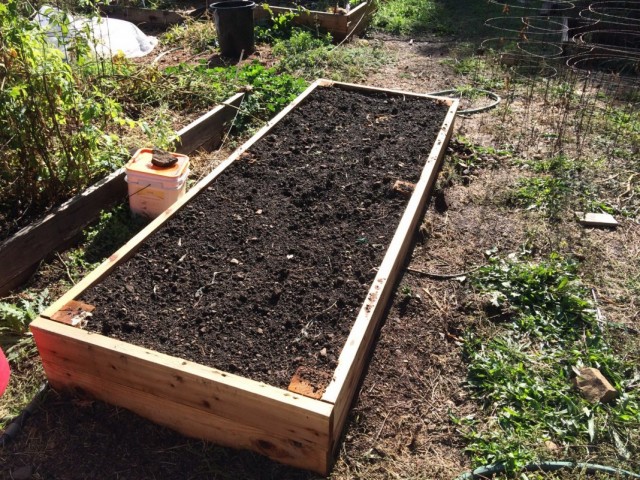 Preparing a bed for planting garlic before winter. © Laura Lemay
Preparing a bed for planting garlic before winter. © Laura Lemay
Soil preparation
As we know, there are different areas, and it’s good when a given area is raised, leveled and the ground on it is like fluff; It’s quite different when the site is low, the soil dries out slowly. What to do? In this case best option- this is the construction of high beds (twenty centimeters is just right). The width of the beds can be any, but usually no one makes them more than a meter wide, it’s easier to weed.
Of course, raised beds have their drawbacks, don’t forget about them. The most important thing: the soil in such beds dries twice as quickly as in a regular bed, but there are also advantages: in the event of rain or excessive watering, the water will drain faster, and such beds warm up in the spring twice as fast as level soil. The main thing is that they are fenced and do not spread throughout the area.
If the soil on your site is acidic, then you can completely abandon the autumn planting of garlic and plant it in the spring. Or a month before planting, add 200 g of lime per square meter beds, digging up the soil well (with a shovel full). Of course, the ideal option is to lim the soil, especially for the predecessor of garlic, but then you will have to abandon both autumn and spring planting. In the fall, 250-300 g of lime are added for digging, early cabbage is planted in the spring, and in the fall next year– winter garlic.
If everything is fine with the soil, that is, its reaction is neutral, then you can add 10-12 kg of humus, a tablespoon of superphosphate and a tablespoon of potassium sulfate to the beds for digging the beds, for each square meter. The main thing in in this case– do not resort to fresh manure, you can use humus, and if there is nothing but manure, then take advantage of the fact that it has lain in a heap for at least four years, that is, it has rotted well.
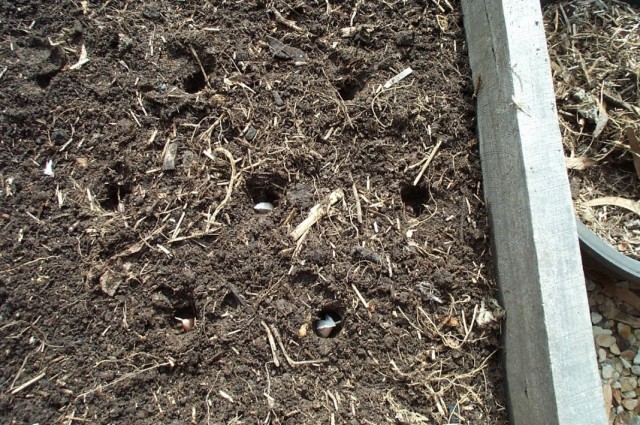 Autumn planting of garlic before winter. © Gavin
Autumn planting of garlic before winter. © Gavin
Additionally, depending on the soil type:
If the soil is very heavy, clayey, dense and both melt and irrigation water stagnate on it for a long time, then it needs to be brought back to normal as quickly as possible. This should be done at least a month before planting garlic; this work is physically difficult and without the possibility of using technology, although it all depends on the size of the future bed with garlic. In order to make the soil loose, it is necessary to add a bucket of peat and river sand to each square meter of soil for deep digging.
If, on the contrary, the soil on your site is excessively loose, that is, sandy, then you need to compact it by adding clay and humus. Before applying, the clay must be dried very well, then crushed literally into the smallest parts to a powder state, and only after that, in combination with sand, can it be applied to the soil. Usually, per square meter for digging you need a bucket of both (that is, sand and clay).
For those with peat soils, which are often acidic, in addition to adding 250 g of lime per square meter, we recommend adding a bucket of sand, always river sand, and clay prepared according to the method described above. All this is introduced under the mandatory digging of the soil.
Planting garlic cloves
Let's start with the traditional and most common planting of garlic - planting cloves. When the bed is ready, leveled, loosened, you need to make rows on it, 18-20 cm apart from each other, and with very wide beds, 25 cm will be just right, but no more. The distance between the garlic cloves depends on their size: small ones can be planted, leaving 14-16 cm between them, larger ones - 19 and even 22 cm; saving soil in this case is simply pointless. Typically, cloves are planted to a depth of four centimeters in loose soil, and to a depth of five or six centimeters in dense soil.
Planting bulb bulbs
Between the rows it is quite possible to make the same distance equal to two tens of centimeters, but between the bulbs ten is enough if they are very small, and 15 cm if they are larger. Plant garlic bulbs on loose soil to a depth of four centimeters, on denser soil - to a depth of five centimeters. Usually, about three dozen bulbs are needed per square meter of bed, less often – more; it’s still not worth being partial with placement.
It is not worthwhile to plant garlic more often for the reason that usually weeds grow quite actively in its plantings and then it becomes elementary difficult to care for it; on top of everything else, banal competition arises between them and the bulbs simply cannot grow large.
You need to prepare the soil before planting garlic 10-15 days in advance, that is, if we plan to plant it at the end of September, then at the beginning of the month it is quite possible to start preparing the soil.
Is it necessary to treat garlic cloves before planting? It is rarely carried out; you can soak it for an hour or two in a light-colored solution of potassium permanganate, but usually success in cultivation lies in further agricultural technology.
On any soil, even the most loose, the maximum depth for a garlic clove is six centimeters, and for bulbs – five centimeters.
You cannot “stick” the garlic cloves too much; they must be carefully “placed” into the soil, for which the soil must first be brought to a loose state.
On planted beds after planting, it is enough to sprinkle the top layer with stove ash, 200 g per square meter.
Watering garlic after planting is not necessary; usually there is enough rain, but if none falls in a month, then you can water it once, using a bucket per square meter.
After the onset of frost, while there is no snow, the garlic can be covered with a layer of 15-25 cm of leaf litter, and a non-woven covering material can be spread over it. Or don’t use the leaves at all, making do with only the material.
In the north, winter garlic is protected - it is covered with straw manure, and horse manure, mixing manure and sawdust in equal parts. You can also cover it with humus in a layer of 18-20 cm. The main thing is to remove this cover as quickly and carefully as possible in the spring so that the soil warms up more actively and does not damage the seedlings.
A month after the snow melts, you can loosen the soil, trying to go 1.5-2 cm deeper, but this is maintenance, that is, another article.
Garlic is a small but very popular plant among gardeners. Thanks to its specific taste, antiviral and antibacterial properties, it is the leader of any garden. To harvest a good harvest, every self-respecting owner should know the favorable days for planting garlic.
Garlic has many beneficial properties, every Russian summer resident grows it. However, not everyone manages to get a good harvest. In order to have excellent cloves in the summer, you need to plant garlic correctly in the fall. And you need to start with choosing planting material, preparing beds and much more.
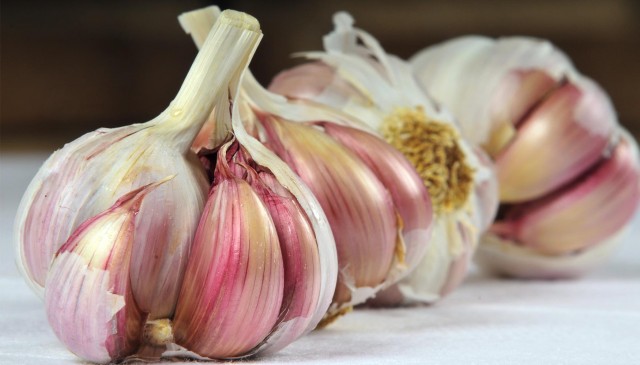
It is best to plant garlic before winter according to the lunar calendar. It is during this period that it is necessary to adhere to the schedule every day - for young teeth this is very important. Proper planting will help the weak seedling take root and survive the winter.
Before planting, be sure to add compost - for every 1 sq.m. - a bucket of fertilizer or humus. Afterwards, dig up the soil, form beds and treat them with a solution of copper sulfate (40 g of powder per 10 liters of water). 1 liter of solution - 1 m? beds.
For planting, choose healthy, dense and large heads raw garlic. It is recommended to separate them into cloves immediately before the planting process - this is done so that the garlic does not have time to dry out. It is not necessary to peel garlic before planting, but many people do it. Do you peel winter garlic before planting it or not and why - share your experience in the comments.

The lunar calendar is a very useful thing, with which you can calculate the best date for planting a particular crop. It was not for nothing that our ancestors turned either to him or to sowing calendar. The most favorable days of September for planting garlic according to the lunar calendar are September 7, 8, 9, 23 and 24. In October, the crop can be planted on the 5th, 6th, 20th and 22nd. Those who are completely late are allowed to plant garlic in November - on the 1st, 2nd, 16th, 17th, 29th and 30th. Just don't count on a good harvest if you plant in November.
Some gardeners prefer to grow spring garlic because it has a longer shelf life. However, there are a number of advantages to planting winter garlic, for example:
1. Saving time during spring work. The landing dates are extended, which allows you to take your time and prepare well for the procedure. In the spring there is too much work in the garden, there is no time to properly prepare the beds and materials, and in the fall there is much more of it.
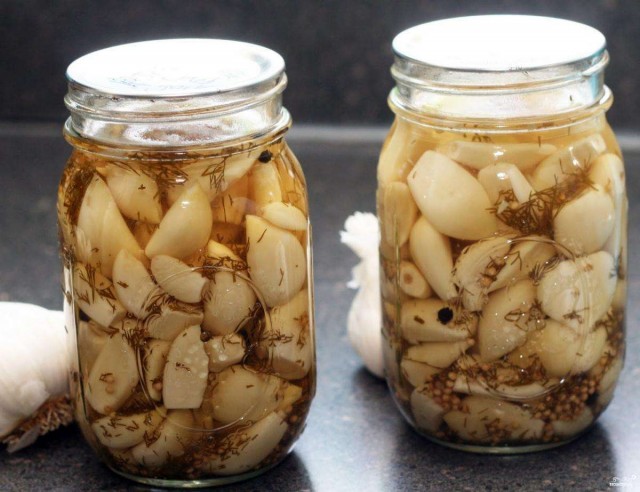
2. Winter garlic is not afraid of frost, while return frosts can destroy the tender shoots of spring garlic.
3. The planting material is quite large, and the small fraction of spring garlic often dries out by the time of planting.
4. Winter garlic is undemanding in care, since there is enough soil moisture for its development.
5. Winter varieties of garlic are more resistant to pests and are less affected by various diseases.
6. The yield of winter garlic is much higher than that of spring garlic.
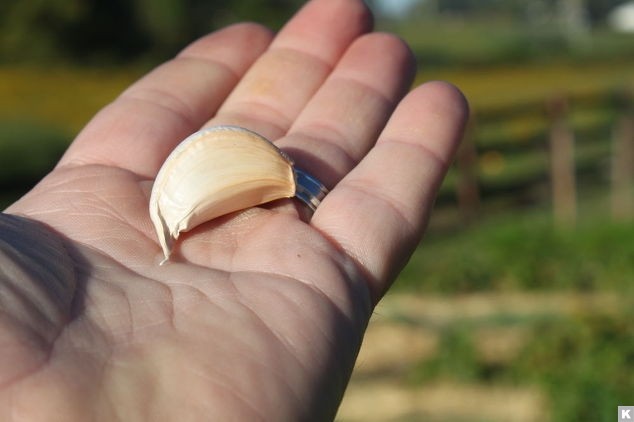
7. Harvesting takes place a month earlier, which allows garlic to be used for summer consumption.
It is common among people to begin the process of planting winter garlic approximately two to three weeks before the arrival of frost. For normal growth, it is important for it to have time to take root. This is usually done in last days September.
But if the air temperature drops below ten degrees, you need to start planting garlic immediately. In order for it not to freeze and be able to endure the winter with a subsequent good harvest, you need to follow a few fairly simple rules.
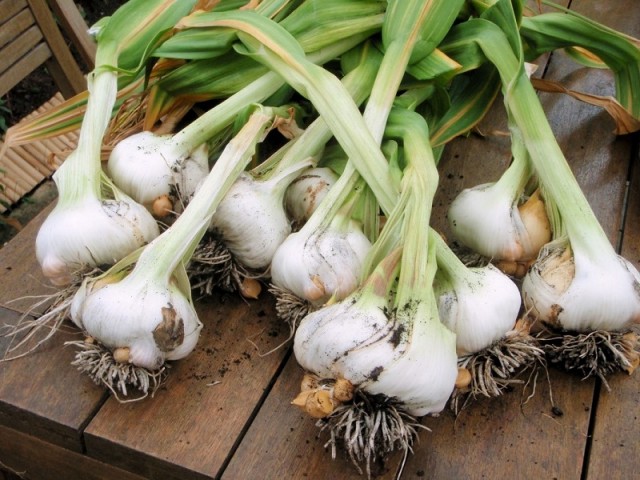
If garlic is planted early, it will sprout. This should not be allowed under any circumstances, and garlic that is planted late will not have time to let the roots freeze.
It is because of this that it is very important to follow the annual planting dates for winter varieties. Before determining a site for winter garlic, you need to find out after which it is recommended to plant garlic, in other words, which vegetables can precede garlic, and after which its growth is impossible.

Experienced gardeners say that garlic will grow best when planted after annual crops with a short growing season - cucumbers, peppers, pumpkins, eggplants or berry bushes. It is not advisable to grow garlic in an area where root crops previously grew - their fruits are harvested late, and the depleted soil does not have time to recover.


